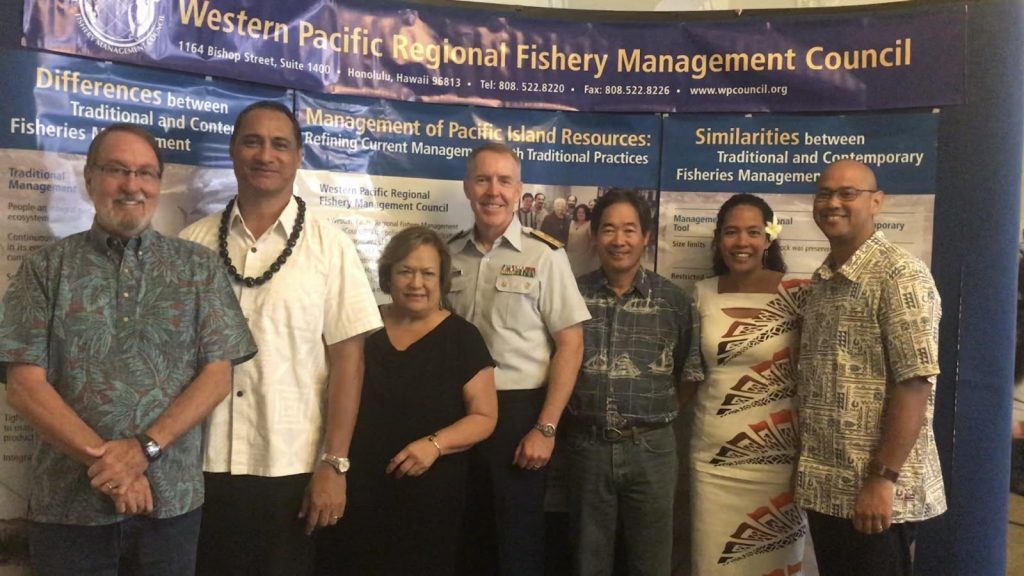August 10, 2022 — The following was released by the Pacific Islands Fisheries Group and the Large Pelagics Research Center:
The most comprehensive effort to date to characterize striped marlin (Kajikia audax) movements in the Central North Pacific has revealed unexpectedly broad movements among tracked specimens, with some traveling to the east coast of Australia or halfway to California from their dispersal points around Hawai‘i.
The original research, funded by a NOAA Saltonstall-Kennedy Program grant, was conducted by scientists associated with the Hawai‘i-based Pacific Islands Fisheries Group (PIFG) and the Large Pelagics Research Center (LPRC) in Massachusetts. It was recently published across two papers in the peer-reviewed journal Frontiers in Marine Science.
The papers’ findings could inform future fisheries management measures affecting striped marlin, at a time when K. audax – a top incidental catch of the longline fishery – is considered overfished in the Western and Central North Pacific.
“There is a major lack of information on the movement and ecology of striped marlin in the Central North Pacific,” said co-author and LPRC Director Molly E. Lutcavage.
“The last dedicated study of striped marlin in the Central North Pacific was almost two decades ago, and involved only a handful of marlin captured by recreational, or sport, fishers.”
Lead author Chi Hin Lam, Clayward Tam and Lutcavage partnered with commercial vessels belonging to the Hawaii Longline Association to deploy 31, $4,000 popup archival satellite tags (PSATs) on striped marlin between 2016 and 2019. Tam’s cooperative, science-based relationships with skilled longline captains made the partnerships successful.
“This is another example of the Hawaii longline vessels playing a significant role in cooperative research with leading scientists,” said Eric Kingma, Executive Director of the Hawai’i Longline Association (HLA). “We have a long history of scientific collaboration and our fleet has served as a research platform for decades. HLA congratulates the authors on their important findings and looks forward to working with PIFG and other scientists on future fisheries management and marine conservation research.”
The PSATs recorded vast horizontal movements throughout the Pacific Ocean, challenging previously-held notions that striped marlin are highly localized in their regional, coastal aggregations.
The tagged marlin, which were tracked for up to one year, routinely crossed multiple fisheries management boundaries and ocean features like seamounts and fracture zones.
One tagged marlin, PG01, made a trans-Pacific journey not previously observed for its species. Having been tagged in the Eastern Pacific Ocean, PG01 eventually made its way thousands of miles to the central east coast of Australia.
“We didn’t expect a tag showing up off Australia,” Lam said. “I would say that was 50% luck and 100% hard work. Consulting with our captains and tagging partners docked at Pier 38 in Honolulu and providing first-hand training for scientific tagging paid off.”
The tags also showed the striped marlin spent 38 and 81% of their day and night, respectively, in the top five meters of the water column.
The papers’ horizontal and vertical movement data is important for fisheries managers and stock assessment scientists, who require timely, high-quality biological and habitat data to inform population modeling and stock status.
Such data also helps identify best practices to support sustainable harvest, which could include mandated live release and time-area restrictions.
“Longline fisheries targeting tuna and swordfish benefit from any scientific information that helps to reduce unintended interaction with non-targeted catch like marlin, while pursuing economic returns on targeted catch of tuna and swordfish,” Lutcavage said.
In addition to monitoring tagged fish, researchers collected fin clips from Hawai‘i-landed striped marlin. Genetic analyses of 55 striped marlin were assigned to two genetic groups: Australia, New Zealand and Hawai‘i (19 individuals) and Hawai‘i alone (36 individuals), suggesting the Hawai‘i-based longline fleet interacted with individuals from multiple populations.
Lam, Tam and Lutcavage believe more PSAT efforts and genetics analyses are called for, to fill in the scientific gaps underscored by their latest striped marlin research. Improved technology and knowledge of the species’ biology, physiology and life history will better inform management measures for the sustainable harvest of bigeye tuna and swordfish, and a reduction of incidental catch of non-target species like the striped marlin.

